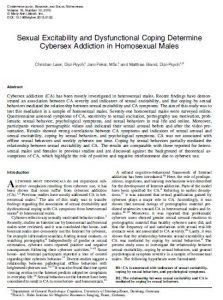Mental Health
Sexual Excitability and Dysfunctional Coping Determine Cybersex Addiction in Homosexual Males
 Full Article Title: Sexual Excitability and Dysfunctional Coping Determine Cybersex Addiction in Homosexual Males
Full Article Title: Sexual Excitability and Dysfunctional Coping Determine Cybersex Addiction in Homosexual Males
Open Access: No
Abstract
Cybersex addiction (CA) has been mostly investigated in heterosexual males. Recent findings have demonstrated an association between CA severity and indicators of sexual excitability, and that coping by sexual behaviors mediated the relationship between sexual excitability and CA symptoms. The aim of this study was to test this mediation in a sample of homosexual males. Seventy-one homosexual males were surveyed online. Questionnaires assessed symptoms of CA, sensitivity to sexual excitation, pornography use motivation, problematic sexual behavior, psychological symptoms, and sexual behaviors in real life and online. Moreover, participants viewed pornographic videos and indicated their sexual arousal before and after the video presentation. Results showed strong correlations between CA symptoms and indicators of sexual arousal and sexual excitability, coping by sexual behaviors, and psychological symptoms. CA was not associated with offline sexual behaviors and weekly cybersex use time. Coping by sexual behaviors partially mediated the relationship between sexual excitability and CA. The results are comparable with those reported for heterosexual males and females in previous studies and are discussed against the background of theoretical assumptions of CA, which highlight the role of positive and negative reinforcement due to cybersex use.
Citation
Laier, C., Pekal, J., & Brand, M. (2015). Sexual excitability and dysfunctional coping determine cybersex addiction in homosexual males. Cyberpsychology, Behavior, and Social Networking, 18(10), 575–580. https://doi.org/10.1089/cyber.2015.0152

